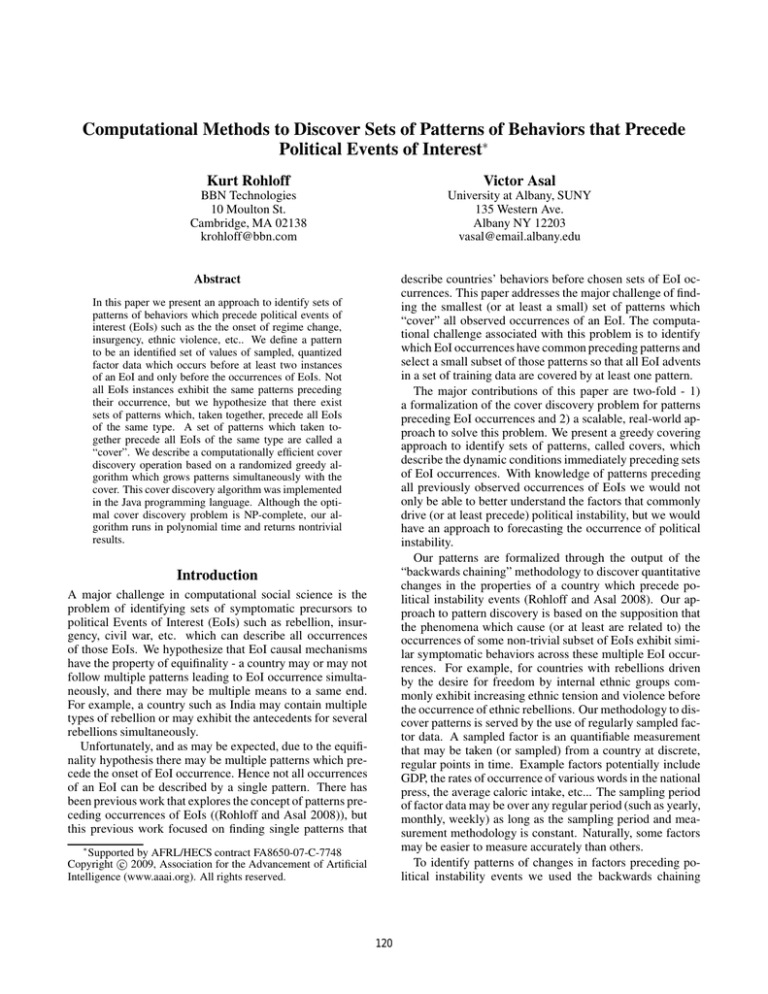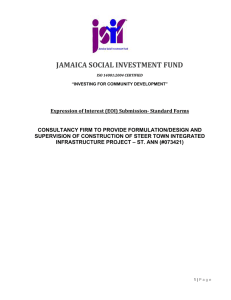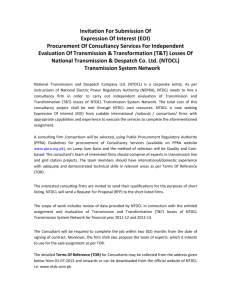
Computational Methods to Discover Sets of Patterns of Behaviors that Precede
Political Events of Interest∗
Kurt Rohloff
Victor Asal
BBN Technologies
10 Moulton St.
Cambridge, MA 02138
krohloff@bbn.com
University at Albany, SUNY
135 Western Ave.
Albany NY 12203
vasal@email.albany.edu
describe countries’ behaviors before chosen sets of EoI occurrences. This paper addresses the major challenge of finding the smallest (or at least a small) set of patterns which
“cover” all observed occurrences of an EoI. The computational challenge associated with this problem is to identify
which EoI occurrences have common preceding patterns and
select a small subset of those patterns so that all EoI advents
in a set of training data are covered by at least one pattern.
The major contributions of this paper are two-fold - 1)
a formalization of the cover discovery problem for patterns
preceding EoI occurrences and 2) a scalable, real-world approach to solve this problem. We present a greedy covering
approach to identify sets of patterns, called covers, which
describe the dynamic conditions immediately preceding sets
of EoI occurrences. With knowledge of patterns preceding
all previously observed occurrences of EoIs we would not
only be able to better understand the factors that commonly
drive (or at least precede) political instability, but we would
have an approach to forecasting the occurrence of political
instability.
Our patterns are formalized through the output of the
“backwards chaining” methodology to discover quantitative
changes in the properties of a country which precede political instability events (Rohloff and Asal 2008). Our approach to pattern discovery is based on the supposition that
the phenomena which cause (or at least are related to) the
occurrences of some non-trivial subset of EoIs exhibit similar symptomatic behaviors across these multiple EoI occurrences. For example, for countries with rebellions driven
by the desire for freedom by internal ethnic groups commonly exhibit increasing ethnic tension and violence before
the occurrence of ethnic rebellions. Our methodology to discover patterns is served by the use of regularly sampled factor data. A sampled factor is an quantifiable measurement
that may be taken (or sampled) from a country at discrete,
regular points in time. Example factors potentially include
GDP, the rates of occurrence of various words in the national
press, the average caloric intake, etc... The sampling period
of factor data may be over any regular period (such as yearly,
monthly, weekly) as long as the sampling period and measurement methodology is constant. Naturally, some factors
may be easier to measure accurately than others.
To identify patterns of changes in factors preceding political instability events we used the backwards chaining
Abstract
In this paper we present an approach to identify sets of
patterns of behaviors which precede political events of
interest (EoIs) such as the the onset of regime change,
insurgency, ethnic violence, etc.. We define a pattern
to be an identified set of values of sampled, quantized
factor data which occurs before at least two instances
of an EoI and only before the occurrences of EoIs. Not
all EoIs instances exhibit the same patterns preceding
their occurrence, but we hypothesize that there exist
sets of patterns which, taken together, precede all EoIs
of the same type. A set of patterns which taken together precede all EoIs of the same type are called a
“cover”. We describe a computationally efficient cover
discovery operation based on a randomized greedy algorithm which grows patterns simultaneously with the
cover. This cover discovery algorithm was implemented
in the Java programming language. Although the optimal cover discovery problem is NP-complete, our algorithm runs in polynomial time and returns nontrivial
results.
Introduction
A major challenge in computational social science is the
problem of identifying sets of symptomatic precursors to
political Events of Interest (EoIs) such as rebellion, insurgency, civil war, etc. which can describe all occurrences
of those EoIs. We hypothesize that EoI causal mechanisms
have the property of equifinality - a country may or may not
follow multiple patterns leading to EoI occurrence simultaneously, and there may be multiple means to a same end.
For example, a country such as India may contain multiple
types of rebellion or may exhibit the antecedents for several
rebellions simultaneously.
Unfortunately, and as may be expected, due to the equifinality hypothesis there may be multiple patterns which precede the onset of EoI occurrence. Hence not all occurrences
of an EoI can be described by a single pattern. There has
been previous work that explores the concept of patterns preceding occurrences of EoIs ((Rohloff and Asal 2008)), but
this previous work focused on finding single patterns that
∗
Supported by AFRL/HECS contract FA8650-07-C-7748
c 2009, Association for the Advancement of Artificial
Copyright Intelligence (www.aaai.org). All rights reserved.
120
Boolean perspective that is usually used across a wide selection of cases. From a policy perspective our efforts allow
us to identify combinations of changing patterns of behaviors within particular larger sociopolitical contexts that are
likely, based on past experience to lead to EoI outbreaks at a
temporal point distant from the actual outbreak.
For the backwards chaining process we identify which
factors change in the same manner for several time steps
leading up to all occurrences of a particular EoI. The combination of all of the factors which all change in the same
manner for a fixed number of time steps leading up to all occurrences of a particular EoI define a pattern. By identifying
which specific factors which in combination exhibit symptomatic behavior leading to EoI occurrences, we are closer
to our ongoing goal of obtaining early warning derivative results informed by factor combinatorics in a semi-automated
manner. Our hypothesis is that by identifying such a pattern,
one can use this pattern to detect conditions which are precursors to the occurrences of EoIs and hence have a forecasting capability for EoI occurrence. It is important to note that
a country may or may not follow multiple patterns leading
to EoI occurrence simultaneously, and there may be multiple means to the same end. For example, a country such as
India may contain multiple types of rebellion or may exhibit
the antecedents for several rebellions simultaneously.
It is important to underline that our efforts here differ fundamentally from the usual computational approaches taken
to the study of social processes. Most computational analysis embraces a quantitative statistical methodology that examines if a host of variables each separately or (occasionally) in interaction impact significantly a dependent variable
of interest. The relative nature of this impact can then be
expressed in probabilities and caveated by confidence intervals. The approach has the advantage of controlling for a
variety of variables and for having an established metric for
the impact of each variable. Researchers who use qualitative
literature have identified several key problems with this approach though. For our purposes it is important to note two
of these critiques. First the statistical approach focuses on
probabilities rather than patterns. That is that the possibility
that it is a wide range of factors forming a specific constellation of factors that account for the advent of a particular
EOI is missing from this approach (Ragin 2000). In addition what is missing is an accounting of this constellation
might combine over time to produce certain results that are
temporally dependent and contingent (George and Bennett
2005). We take this temporal path dependency seriously. Finally our approach differs because our approach takes equifinality, the argument that different combinations of factors
can result in the same EOI, seriously (George and Bennett
2005). Instead of using a probabilistic approach, we look
to identify those temporal pattern combinations that explain
the outbreak of an EOI and we look to identify all the patterns that do so in a coherent fashion. Our covering efforts
allow us to do this in a novel way examining a wide range
of data at the same time that goes far beyond what similarly
minded qualitative approaches have been able to do so far.
Our analytical effort is being driven by an approach that
does not privilege any particular social science theoreti-
methodology. The backwards chaining methodology permits us to identify which factors change identically over a
fixed number of time steps in the time period leading up to
the occurrences of events of interest in selected countries.
The identification of how specific factors change over time
leading to the occurrence of an EoI defines a pattern in the
context of our backwards chaining methodology.
Unfortunately, the size of the set of all possible patterns
for subsets of EoI occurrences is exponential in the number
of EoI occurrences in the worst case. Therefore we cannot
use a brute-force approach to discovering all possible patterns that could be used to form a cover. We present a greedy
algorithm which incrementally grows patterns that cover a
set of EoI occurrences. We implemented this algorithm in
the Java programming language.
This document is organized as follows. The section immediately following discusses the theoretical basis for our
analysis. We then formalize the covering discovery problem
and then review the relevant concepts the backwards chaining approach to pattern definition described in (Rohloff and
Asal 2008). We then describe our greedy covering algorithm
which runs in polynomial time. We also discuss how our
solution methods are scalable. We close the paper with a
discussion of our results.
A Theoretical Basis for the Pattern Cover
Concept
We start our investigation with the belief that the outbreak
of violence will be characterized by equifinality, “many alternative causal paths to the same outcome,” (George and
Bennett 2005) in other words there is not one cause of EoI
outbreaks. There may be a set of factors that make those
outbreaks more or less likely but we believe there are a set
of potential causal pathways that are likely to lead to outbreak of non-state actor violence towards the state. We are
interested in exploring the combinational power of various
factors as they lead to EoIs. To do this we build on efforts
to use Boolean analysis (Ragin 2000) to understand political activity while allowing for multiple causal mechanisms
(Chan 2003). Given that this approach is usually pursued to
examine a small number of cases, the focus is on those factors that are thought to be likely to be explanatory rather than
also collect data on the general environment (the dogs that
dont bark - and the cats that never would) as well as those
occasions where there is an outbreak of an EoI (for example
see: (Chan 2003)).
The ability to apply a computational approach to this analytical effort allows us to do several things that otherwise
not be possible. First we are not limited to a small number
of cases nor are we limited to a small number of variables
but we are able to look across a wide range of variables to
see which variables build patterns that lead to the outbreak
of an EoI including focusing on might be unlikely but possible combinations of variables. Second, this computational
approach allows us to take into account the way variables
combine over time to produce outcomes. Thus a major innovation in our efforts is the ability to meld a component
of temporality from a process tracing perspective with the
121
patterns of change within a broader unchanging state space
that leads to violence
cal bias related to violent conflict (for example the greed
- grievance argument). Instead we have endeavored to draw
from various theoretical models we have been able to find
and to operationalize theories in an analytically useful way.
Our efforts are directed at creating a synthesis that draws
from each of major theoretical models that tries to explain
substate political violence. We drew explicitly from the
greed (Collier et al. 2003), grievance (Gurr 2000) , resource
mobilization (McAdam, McCarthy, and Zald 1996), political opportunity structure, (external and demographic) pressures (Tarrow 2001), culture/values (Goldstone 2001) and
leadership literatures (Herman and Herman 1989). In this
effort we are looking to identify factors that help explain
rare events - the outbreak of different kinds of political violence. In general we view EoI emergence, as a product of
interactions between causal factors at different levels of a social environment. Some aspects of that social environment
are more changeable and stochastic while other aspects are
relatively rigid and predictable. These variables combine in
different patterns to produce future behavior-in our case patterns of violence.
In our current analysis we focus on the variables that
change leading up to the EoIs but we should point out that
the backward chaining approach we are using allows us to
also identify the ongoing unchanging factors that go into
creating a state space where the changes in particular behavioral and policy factors move a country towards experiencing an EoI. The larger state space of countries primed for
an EoI are defined by elements like general political instability married to anocratic (regimes between democracy and
autocracy) political structures or low levels of militarization.
What we find is that when these types of conditions exist the
stage is set for an EoI. The stage though is not what sparks
the EoI.
Across the different EoIs we are finding that a general decline in good rhetoric and behavior and a rise in bad rhetoric
and behaviors give rise to the outbreak of EoIs given certain
structurally negative state spaces as noted above. Certain
variables repeat across EoIs as leading behavioral indicators.
Specifically:
The Pattern Covering Problem
In this section we formalize the cover discovery problem.
For every class of EoI (such riot, rebellion, coups, etc...)
there are a set of instances of those EoIs. More formally,
E = {e1 , e2 , . . .} where ei is an instance of an EoI and E is
the set of instances of a class of EoI. The set E could include
all instances of coups over a geographic area and region in
time.
A pattern P describes the dynamic sets of behaviors
which precede some subset of EoI instances. Formally,
each pattern describes behavior preceding multiple EoI ocP1
1
currences: {eP
1 , e2 , · · ·} = EP1 ⊆ E. We call a pattern
sufficient if it discriminates EoI instances. That is, a pattern
is sufficient for a geographic area and region in time if an
EoI occurs after every time a country follows a pattern. For
any set of EoI instances {ei1 , ei2 , . . .} there may or may not
be a pattern that describes those sets of EoIs.
With this motivation we define a cover to be a set of patterns such that each EoI instance is described by at least
one pattern. More formally, a cover C is a set of patterns
C = {P1 , P2 , · · ·} such that
E = ∪Pi ∈C EPi .
(1)
We therefore define the cover discovery problem such that
when given a set of EoI occurrences E = {e1 , e2 , . . .},
find a set of patterns C = {P1 , P2 , · · ·} such that E =
∪Pi ∈C EPi . Ideally the cardinality of the cover (|C|) should
be as small as possible.
Unfortunately the brute-force approach to cover discovery is computationally intractable in the worst case. For a
set of patterns {P1 , P2 , . . .}, the problem of selecting the
smallest set of patterns to form a cover C is equivalent to
the Set-Covering problem which is well known to be NPcomplete (Garey and Johnson 1979). Notice also that the
set of all subsets of E is exponential in the cardinality of
E so it is infeasible to compute all sets of patterns that
can be used to define a cover. Therefore we cannot directly use standard randomized set-covering algorithms that
could otherwise be used to discover minimal pattern covers
with high probability (Cormen, Leiserson, and Rivest 1990;
Motwani and Raghavan 1995).
Fortunately, using the backwards chaining methodology
(outlined immediately below), when given a set of events
{ei1 , ei2 , . . .} we can quickly test for and find a pattern P
such that EP = {ei1 , ei2 , . . .} if such a pattern exists. We
can take advantage of this pattern discovery approach to efficiently find a small pattern cover with high probability using
a randomized greedy covering algorithm described below.
• The general count of good behavior goes down.
• Efforts at public diplomacy go down.
• Protest behavior tends to go down.
The first two changes are fairly intuitive - good behavior is
an encoding of how often good expressions appeared in the
popular press for a given country over a 1-month time span.
The changes latter may be seen as counterintuitive in that
we can think of protests as a step forward on the continuum
of contentious behavior (McAdam, Tarrow, and Tilly 2001).
On the other hand if we envision contention as a choice between several kinds of contention (each one exacting a cost)
then the withdrawal from a non-violent contention may be a
sign that opposition groups are repositioning their resources
for more violent approaches and governments are expending
resources to drive this behavior down - perhaps unwittingly
pushing opponents into activities that are much more dangerous. Overall, our approach allows us to model different
The Backwards Chaining Methodology
In this section we present our methodology for automatically discovering patterns based on the backwards chaining methodology process. We implemented this process in
the Java programming language to automatically obtain data
122
In general, we search for patterns that lead to EoIs driven
by (or at least related to preceding) government policy and
immediate antecedent behavior. Examples of this preceding (and possibly driving) behavior include shifts in government policy and economic performance. These antecedent
conditions can create agitation and spark violence amongst
the country’s population when expectations are let down or
there is a spike in repression. It is important to note that we
are searching for and forecasting on factors acting in combination and over time which cause the advent of events of
interest. Contextual information is non-trivial: some factors
in a pattern state space might not change over time, but they
set an important context for the country’s state evolution.
An overview of our process of identifying factors for a
pattern are as follows: (We describe these steps in detail below.)
1. Identify EoI occurrences for which patterns should be
identified.
2. Quantize Factor Data.
3. Determine which factors are identical for all instances for
a user-specified number of times steps before EoI occurrence.
This back-chaining process is discussed in more depth in
(Rohloff and Asal 2008). However, to present our cover discovery algorithm in the immediately following section we
represent the result of our backwards-chaining pattern discovery algorithm as P̃ (Ei , F ) for the factor data F and a
set of EoIs Ei = {ei1 , ei2 , . . .}. In general P̃ : 2E × F →
{∅, P1 , P2 , . . .} where P̃ (Ei , F ) = ∅ if a run of the backwards chaining algorithm cannot find a pattern to describe
from a data server, search over the data in an automated manner to identify key factor changes that precede selected EoIs
to identify patterns. A version of this pattern discovery process is discussed in more detail in (Rohloff and Asal 2008).
To discover patterns using the backwards chaining
methodology we developed algorithms and wrote software
to identify factors that change “identically” over a fixed
number of sample times in the time period leading up to
the occurrences of user-selected EoI advents. We define
an equivalence relationship for the factor values based on
quantization levels of those factors that was implemented in
our factor identification tool. We use that equivalence relationship to determine when changes in factors are similar
enough to be called “identical”.
For the backwards chaining methodology, we define a pattern for the advent of an EoI to be:
1. A set of factors, and
2. A description on how each of those factors change quantitatively for a number of time steps before the advent of
an Event of Interest in at least two distinct instances.
We require that patterns discriminate. That is, the patterns
should not match the behavior in any country when and
where an EoI does not occur. The set of factors which define a pattern may include a factor that represents previous
occurrences of the advent of the EoI itself. By the nature
of the factor data used in our pattern discovery process, we
can incorporate discrete event occurrences in our patterns by
representing the occurrences of these events as a binary factor. In this manner we can incorporate catastrophic events in
our patterns such as the ongoing global financial crisis or a
natural disaster of very large proportions like the tsunami in
2006 that may not be directly related to a political event of
interest (EoIs) but have a significant impact on EoIs.
An example of a hypothetical identification of two factors
that change identically in the time preceding the occurrence
of an EoI is seen in Figure 1. This figure shows the values of
two factors (quality of government and level of corruption)
for two countries for several quarters preceding the occurrence of the EoI rebellion. The trajectory of one country is
shown using a black line and the trajectory of a second country is shown using a light blue line. In this example, the values of the Quality of Government and Corruption are nearly
the same for up to three quarters before the occurrence of
Rebellion.
Although the graphical example in Figure 1 identifies a
pattern in two different countries for two factors, our patterns could be derived from the behavior of any number of
countries using any number of factors. Most importantly,
our pattern discovery process search over the set of available
factors to identify the specific factors that change identically
in the time-steps leading up to EoI occurrences.
In the context of our backwards chaining methodology,
the set of factors that define a pattern represents the specific aspects of the condition of a country at particular moments in time. Based on discovered patterns of changes in
factors leading to the advent of EoIs, we can generate earlywarning forecasts of EoIs if early portions of the patterns are
observed in real-time for a specific country.
4 Quarters
Before Rebellion
2 Quarters
Before Rebellion
4 Quarters
Before Rebellion
Factor 2
5 Quarters
Before Rebellion
3 Quarters
Before Rebellion
Rebellion
5 Quarters
Before Rebellion
1 Quarter
Before Rebellion
Factor 1
Figure 1: The identification of factors leading to an EoI.
123
the behavior preceding the EoIs in Ei . Note that although
P̃ (Ei , F ) is a random variable, P̃ (Ei , F ) = ∅ if and only
if there is no pattern of behavior to describe the changes in
factor data preceding the occurrences in Ei .
EoIs to the pattern subset. If an EoI can be added, then it
is kept in the subset. If the EoI cannot be added, then it is
removed from the subset.
The variable toCover tracks the set of EoIs that have not
been successfully added to a pattern. Note that if there exists
a cover, Algorithm 1 will find one. The only way that an EoI
is not covered by a pattern in a cover would be if the EoI
were one of the “seed” EoIs such that no other EoIs could
be used with it to construct a valid pattern P . This happens
if ∀e ∈ E, P̃ ({e, e }, F ) = ∅. If this is the case then there
can be no cover for all EoIs in E.
Note that Algorithm 1 runs in polynomial time with respect to E
. This is discussed in more detail in the section
immediately following. Although Algorithm 1 will not always find the optimal cover, we have found in practice that
it generally finds a cover with an acceptably low cardinality. Indeed, due to its similarity to greedy randomized algorithms for the set covering problem, one can show that
Algorithm 1 has a good performance ratio for the closeness
of the cardinality of its covering solution to the optimal covering solution.
Pattern Covering
We use our pattern discovery process to identify covers. The
basis of our cover discovery operation is that we incrementally attempt to identify patterns that describe a specific portion of the EoI occurrences in our training data which are
not adequately described by other discovered patterns. Our
basis of this cover discovery is a randomized process that repeatedly selects randomized subsets of EoIs and discovers a
minimized pattern for that subset of EoIs. This pattern discovery process terminates when all EoIs are either covered
by at least one pattern or a pattern has attempted to have
been constructed for every EoI not covered and every other
EoI. An algorithm for our pattern discovery process is below
in Algorithm 1.
Data: A set of EoIs E and factor data F .
Result: A cover C = {P1 , P2 , . . .} such that
E = ∪Pi ∈C EPi .
C := ∅;
P := ∅;
toCover := E;
covered := ∅;
while toCover is non-empty do
Remove randomly selected e from toCover;
E := {e};
toT est := toCover ∪ covered;
while toT est = ∅ do
Remove randomly selected e from toT est;
E := E ∪ {e};
Compute P := P̃ (E , F );
if P == ∅ then
Remove e from E ;
else
if e ∈ toCover then
move e from toCover to covered;
end
end
end
if P = ∅ then
C := C ∪ P
end
end
Algorithm 1: Randomized Greedy Cover Discovery
Scalability
An advantage of our cover discovery process is that it scales
well to situations with very large numbers of factors and
very large numbers of EoIs. The keystone of this scalability for cover discovery is the scalability of the backchaining process for pattern discovery. As discussed in
(Rohloff and Asal 2008), the computation time of the our
backwards chaining pattern discovery process grows linearly in the number of factors and linearly in the number
of countries used to define a pattern. This is because the
back-chaining process tests factor for inclusion in the pattern independently of one another and are tested once for
each country at a time. To use assymptotic big-O notation,
O(t(P̃ (E, F ))) ⊆ O(|E|poly(|F |))
Algorithm 1 calls the pattern discover back-chaining process a polynomial number of times with respect to the number of EoIs to be covered to leverage the scalability of the
pattern-discovery process for a scalable cover discovery process. The outer loop of Algorithm 1 iterates at most |E|
times and the inner loop of Algorithm 1 similarly iterates at
most |E| times. Consequently the run time of Algorithm 1 is
in O(|E|2 ) × O(t(P̃ (E, F ))) ⊆ O(|E|3 poly(|F |)). Hence
Algorithm 1 is scalable.
In Algorithm 1, patterns are iteratively grown in a randomized manner such that every grown pattern covers at
least one previously uncovered EoI. The algorithm terminates when all EoIs are covered. To discover the patterns
in the cover, the algorithm iteratively and randomly grows
a subset of EoIs and a corresponding pattern from a “seed”
EoI that has not been previously covered by a pattern in the
cover. As this subset of EoIs and the pattern is grown, the algorithm iteratively and randomly attempts to add additional
Conclusion
In this paper we presented the notion of a pattern cover to
describe patterns of possible behavior preceding the onset of
EoIs. We formalized the problem of cover discovery based
and presented an computationally efficient randomized algorithm that discovers covers. If a pattern exists, then our algorithm will find a cover to solve the cover discovery problem.
124
References
Ragin, C. C. 2000. Fuzzy-set social science. University of
Chicago Press.
Chan, S. 2003. Explaining war termination: A boolean
Rohloff, K., and Asal, V.
analysis of causes. Journal of Peace Research 40(1):49–
2008.
The identification
of sequential patterns preceding the occurrence of polit-
66.
ical events of interest. In Proceedings of the 2nd InterCollier, P.; Elliott, L.; Hegre, H.; Hoeffler, A.; Reynal-
national Conference onComputational Cultural Dynamics
Querrol, M.; and Sambanis, N. 2003. Breaking the Conflict
(ICCCD).
Trap: Civil War and Development Policy. Oxford: World
Tarrow, S. 2001. Transnational politics: Contention and
Bank and Oxford University Press.
institutions in international politics. Annual Review of PoCormen, T. T.; Leiserson, C. E.; and Rivest, R. L. 1990.
litical Science 4(1):1–20.
Introduction to algorithms. Cambridge, MA, USA: MIT
Press.
Garey, M., and Johnson, D. 1979. Computers and Intractability: A Guide to the Theory of NP-Completeness.
W. H. Freeman.
George, A. L., and Bennett, A. 2005. Case Studies and
Theory Development in the Social Sciences. Boston: The
MIT Press.
Goldstone, J. A. 2001. Toward a fourth generation of
revolutionary theory. Annual Review of Political Science
4(1):139–187.
Gurr, T. R. 2000. People vs. States. Washington D.C.:
United States Institute of Peace.
Herman, M. G., and Herman, C. F. 1989. Who makes
foreign policy decisions and how: An empirical inquiry.
International Studies Quarterly 33(4):361–387.
McAdam, D.; McCarthy, J. D.; and Zald, M. N. 1996.
Comparative perspectives on social movements : political
opportunities, mobilizing structures, and cultural framings.
Cambridge, New York: Cambridge University Press.
McAdam, D.; Tarrow, S.; and Tilly, C. 2001. Dynamics of
Contention. Cambridge: Cambridge University Press.
Motwani, R., and Raghavan, P. 1995. Randomized algorithms. New York, NY, USA: Cambridge University Press.
125





